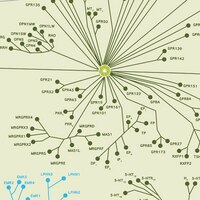Utilization of two seven-transmembrane, G protein-coupled receptors, formyl peptide receptor-like 1 and formyl peptide receptor, by the synthetic hexapeptide WKYMVm for human phagocyte activation.
Le, Y, et al.
J. Immunol., 163: 6777-84 (1999)
1998
Mostra il sommario
Trp-Lys-Tyr-Val-D-Met (WKYMVm) is a synthetic leukocyte-activating peptide postulated to use seven-transmembrane, G protein-coupled receptor(s). In the study to characterize the receptor(s) for WKYMVm, we found that this peptide induced marked chemotaxis and calcium flux in human phagocytes. The signaling induced by WKYMVm in phagocytes was attenuated by high concentrations of the bacterial chemotactic peptide fMLP, suggesting that WKYMVm might use receptor(s) for fMLP. This hypothesis was tested by using cells over expressing genes encoding two seven-transmembrane receptors, formyl peptide receptor (FPR) and formyl peptide receptor-like 1 (FPRL1), which are with high and low affinity for fMLP, respectively. Both FPR- and FPRL1-expressing cells mobilized calcium in response to picomolar concentrations of WKYMVm. While FPRL1-expressing cells migrated to picomolar concentrations of WKYMVm, nanomolar concentrations of the peptide were required to induce migration of FPR-expressing cells. In contrast, fMLP elicited both calcium flux and chemotaxis only in FPR-expressing cells with an efficacy comparable with WKYMVm. Thus, WKYMVm uses both FPR and FPRL1 to stimulate phagocytes with a markedly higher efficacy for FPRL1. Our study suggests that FPR and FPRL1 in phagocytes react to a broad spectrum of agonists and WKYMVm as a remarkably potent agonist provides a valuable tool for studying leukocyte signaling via these receptors. | 10586077
 |



















